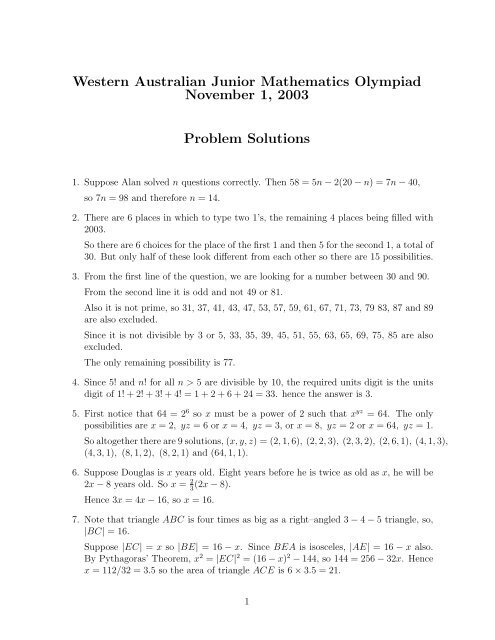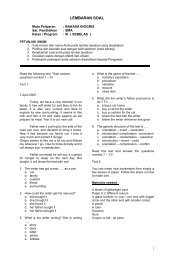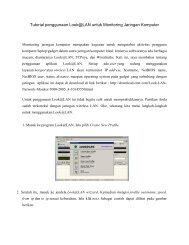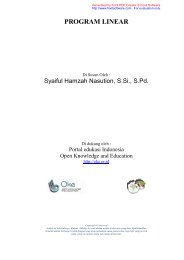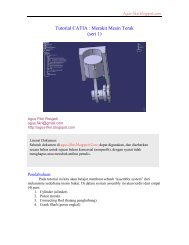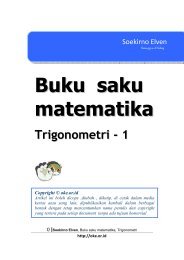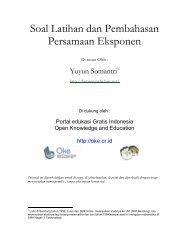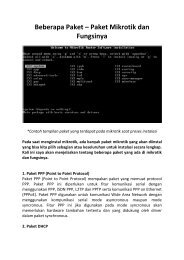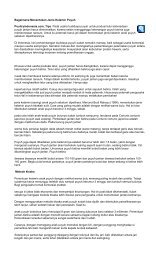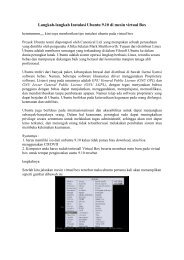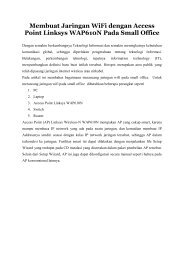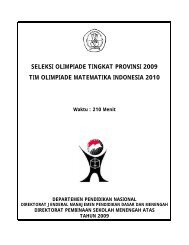You also want an ePaper? Increase the reach of your titles
YUMPU automatically turns print PDFs into web optimized ePapers that Google loves.
Western Australian <strong>Junior</strong> <strong>Mathematics</strong> <strong>Olympiad</strong><br />
November 1, <strong>2003</strong><br />
Problem Solutions<br />
1. Suppose Alan solved n questions correctly. Then 58 = 5n − 2(20 − n) = 7n − 40,<br />
so 7n = 98 and therefore n = 14.<br />
2. There are 6 places in which to type two 1’s, the remaining 4 places being filled with<br />
<strong>2003</strong>.<br />
So there are 6 choices for the place of the first 1 and then 5 for the second 1, a total of<br />
30. But only half of these look different from each other so there are 15 possibilities.<br />
3. From the first line of the question, we are looking for a number between 30 and 90.<br />
From the second line it is odd and not 49 or 81.<br />
Also it is not prime, so 31, 37, 41, 43, 47, 53, 57, 59, 61, 67, 71, 73, 79 83, 87 and 89<br />
are also excluded.<br />
Since it is not divisible by 3 or 5, 33, 35, 39, 45, 51, 55, 63, 65, 69, 75, 85 are also<br />
excluded.<br />
The only remaining possibility is 77.<br />
4. Since 5! and n! for all n > 5 are divisible by 10, the required units digit is the units<br />
digit of 1! + 2! + 3! + 4! = 1 + 2 + 6 + 24 = 33. hence the answer is 3.<br />
5. First notice that 64 = 2 6 so x must be a power of 2 such that x yz = 64. The only<br />
possibilities are x = 2, yz = 6 or x = 4, yz = 3, or x = 8, yz = 2 or x = 64, yz = 1.<br />
So altogether there are 9 solutions, (x, y, z) = (2, 1, 6), (2, 2, 3), (2, 3, 2), (2, 6, 1), (4, 1, 3),<br />
(4, 3, 1), (8, 1, 2), (8, 2, 1) and (64, 1, 1).<br />
6. Suppose Douglas is x years old. Eight years before he is twice as old as x, he will be<br />
2x − 8 years old. So x = 2 (2x − 8).<br />
3<br />
Hence 3x = 4x − 16, so x = 16.<br />
7. Note that triangle ABC is four times as big as a right–angled 3 − 4 − 5 triangle, so,<br />
|BC| = 16.<br />
Suppose |EC| = x so |BE| = 16 − x. Since BEA is isosceles, |AE| = 16 − x also.<br />
By Pythagoras’ Theorem, x 2 = |EC| 2 = (16 − x) 2 − 144, so 144 = 256 − 32x. Hence<br />
x = 112/32 = 3.5 so the area of triangle ACE is 6 × 3.5 = 21.<br />
1


